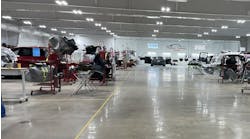The Audi TT may be a new car, but there's a lot of history behind it. The Audi Turbo Coupe Quattro of the early '80s broke new ground in automotive performance and handling. Later models from the VW/Audi family, like the GTi, Scirocco and Corrado, both widened and refined the definition of the modern German sports coupe.
The Audi TT is more than just the latest in this line; it is a node, a focal point, of that rich history. It draws upon the essence of those earlier cars, and inside that new yet historic style, it combines them all into a familiar flavor - one that is very tasty. While the Audi PR folks might be happy to claim these ideas as their own, we came to these conclusions ourselves, based upon personal experience with all these cars, including both versions of the Audi TT.
First, the technical information: Both the 180-horsepower (hp) and 225-hp Quattro versions use the corporate VW/Audi 1.8T iron-block engine, but the Audi head has five valves per cylinder with special intake and exhaust manifolds. The three intake ports cause the air charge to tumble in the combustion chamber, providing excellent mixing for rapid and more complete combustion. Even with 9.5:1 compression, the 180-hp engine can still handle 1.8 BAR of manifold pressure. The small turbo spins up quickly, and boost is available so low in the rev range that peak torque is a constant 173 lb.-ft. from 1,950 rpm through 4,700 rpm.
The 225-hp engine is almost identical, except for different pistons that lower the compression to 9.0:1. The increased power comes from 2.1 BAR of boost and a second intercooler. The torque 'plateau' of 207 lb.-ft. runs from 2,200 to 5,500 rpm. The Bosch ME 7.5 engine management system uses direct ignition, hot-film mass air sensor, dual knock sensors and drive-by-wire.
The car is based on the VW Golf platform, but the strut front suspension has been modified to handle larger wheels and higher-powered engines. On the front-wheel-drive (FWD) model, the rear suspension is the familiar torsion-beam axle, significantly stiffened for duty in the TT. Rear suspension on the Quattro has semi-trailing arms with upper and lower lateral links. Suspension on both models is quite stiff, but not at all harsh.
The look of the car draws upon the style of Audi race cars from the 1930s, when German engineers embraced the Bauhaus design philosophy of "form-follows-function." The car looks the way it does in order to function as intended. Simple shapes made of brushed aluminum are used for many interior and exterior pieces, and the overall shape of the body is one of the most aerodynamic street cars ever produced.




